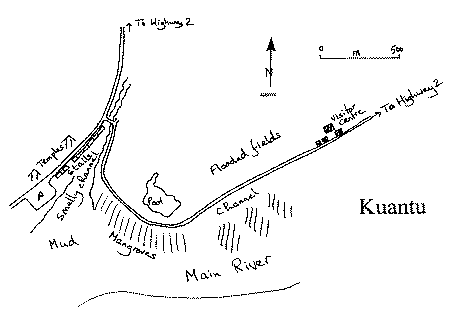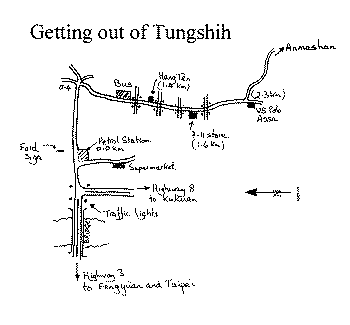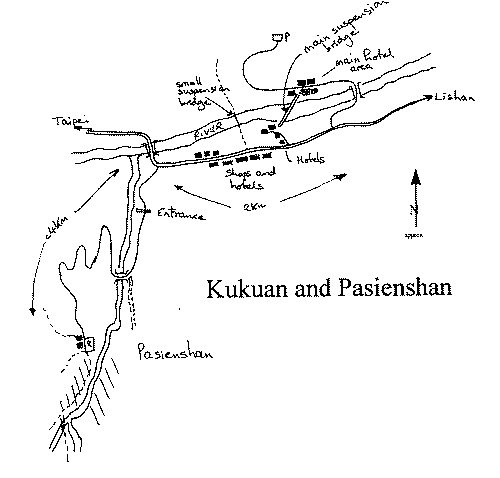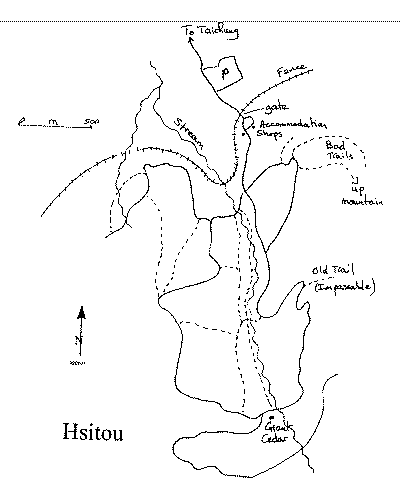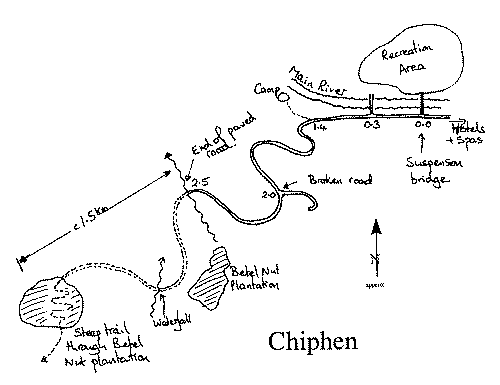Section 1 - Introduction, logistics, itinerary and general information.
Section 2 - Birding sites.
Section 3 - Systematic list.
Birding Sites
|
Included below are details of 26 birding sites, their accommodation, access, habitat and a basic species list for each site (based primarily on my own, and others’ observations, as little published information is available). Species that were seen or heard personally are indicated by the number seen/heard, or with a ‘c’ to denote that the bird was common or fairly so at that site. Species listed without a number have been recorded, but by observers other than me. Bold typeface identifies species of particular note; either rare, endemic, or which might be considered a 'target' bird at that locality. The sites are ordered roughly from north to south. |
Kuantu, Taipei county
The town of Kuantu, at the confluence of the Tamsui and Keelung rivers just northwest of Taipei, is on the standard tourist route owing to its impressive temples. Kuantu “national park” is nothing more than a small “protected” area of ponds, mudflats, mangroves and grassland adjacent to the town. From an ornithological perspective, a visit is interesting for the water birds and migrants that the area attracts. However, the prime reason for our visit was to seek out the vagrant Oriental Stork, a pair of which have been resident for a couple of years - a good opportunity to tick this restricted-range species. To reach Kuantu, 10 kilometres northeast of Taipei, take highway 2 northward from Taipei and turn off left, west, under the highway, signposted Kuantu. Note that as highway 2 is dual carriageway you have to turn off right and then pass under the highway. Continue straight through town (a couple of kilometres) to reach the temples where you will find a sizeable parking area.
About 100 metres before the parking area, and just after the bus terminus, is a narrow bridge between a row of market stalls selling food, both ready-to-go and alive-and-kicking (mainly eels and turtles). It’s probably easiest to park in the car park and walk over the bridge and along the dyke that follows the road. At low tide scan the mudflats from the car park. Although the road over the narrow bridge doesn’t look drivable, it is, and can be followed through the park into agricultural fields which might be interesting for migrants, and from there back onto the highway via a series of farm roads. Undoubtedly the most interesting area is the first couple of kilometres from the bridge as far as the hides and visitor centre - under construction at the time of our visit. Check the few bamboo stands for Vinaceous-breasted Parrotbill. |
|
Species recorded in and around Kuantu:
Little Grebe 1 |
Mongolian Sand-Plover 1 |
Yanmingshan National Park, Taipei county
Being only a stone’s throw away (about 10 km as the crow flies) from downtown Taipei, Yanmingshan National Park is packed with day trippers at weekends and holidays - a time when best avoided. The park protects a sizeable area of forested mountains north of Taipei, and has good hiking, scenic views and geothermal hot spring resorts. As well as many of the commoner resident species such as Rufous-capped Pygmy-Babbler, and Black-browed Barbet, the Taiwan Whistling-Thrush and Taiwan Magpie both occur. Although it might be hard to believe, Yanmingshan is now probably the best place in Taipei county to find the elusive magpie. Birding can be done along any of the roadsides or, better still, the trails which crics-cross the park. There is also a visitor centre, restaurant and Chinese garden. Access from Taipei is via highway 2 northward from the city, with Yanmingshan signposted. Alternatively, you can take the highway from Chinshan on the northeast coast which passes directly through the park. Accommodation can be found readily in Yanmingshan, Shihlin or Taipei - see Lonely Planet for details and suggestions. We stayed at a motel further out along highway 2 going north. Yanmingshan can be combined easily with a half-day trip to Kuantu.
Species recorded in and around Yanmingshan:
Eurasian Hobby 2 |
Light-vented Bulbul c |
Yehliao (Yelhiu), Taipei county
Yehliao, a two to three kilometre peninsula jutting from the mainland in a northeasterly direction, is northern Taiwan’s premier migration hotspot. Unfortunately the day we were here it was completely dead. Other than its attraction for birds, Yehliao park protects a small area of weirdly-shaped, coastal rock formations, formed eons past by wind and rain erosion of uplifted coral reefs. As might be expected these are overun with tourists, but by continuing along the footpath which runs through the park, and out on to the peninsula, stunted trees and bushes on the headland can be investigated. Any of the vegetation can hold migrants, and the headland has a viewing platform, good for sea-watching. Interestingly, the best spot for rarities is behind the public toilet toward the end of the peninsula. Various species of buntings, flycatchers, warblers, thrushes and robins may show up. Regardless, of whether you are going to look at rock formations or birds you will need to pay the small entrance fee.
Yehliao park, along the beach-front of Yehliao town 12 km north of Keelung, is well sign-posted off highway 2. Accommodation can be found in most of the towns along the highway or in Taipei itself. A half-day at Yehliao can be combined easily with a half-day at Yanmingshan or Kuantu. The species list below only includes those recorded by ourselves. A long list of migrants and seabirds could be appended. The nearby Kinshan Youth Activity Centre (not visited by us) is also good for migrants; just walk in the forest in and around the campsite, and try the rice paddies and river nearby. Rare migrants show up often.
Species recorded at Yehliao:
Brown Booby 3 |
Dunlin 3 |
Wulai, Taipei county
Not visited by us. Wulai is probably the best place for forest birds within an hour of Taipei, but is best avoided at weekends when the cooler climate, forests and waterfalls attract the hoards from Taipei. A special bird watching trail runs along Tunghou Brook, which starts close to the Wulai bus stop. Wulai was formerly the best spot near Taipei to find Taiwan Magpie, but numbers are now depleted. However they still occur, together with other specialities; Varied Tit and Brown Dipper. Winter is the best time to visit, when many of the higher elevation species descend to the temperate mid-elevation forest. These include White-eared Sibia, Taiwan Yuhina, Taiwan Liocichla, Taiwan Vivid Niltava, and White-tailed Blue Robin. Further details for visiting, plus maps can be found in the Lonely Planet guide. Accommodation can be found in Wulai itself, or stay in Taipei.
Ilan marshes and nearby estuaries, Ilan county
Not visited by us. The Ilan marshes, located around the town of Ilan can be viewed from the main Highways 7 and 9 passing through town. During migration and winter the area hosts large numbers of waders, ducks and waterbirds. Just to the east, the estuary of Tunkang is a good site for gulls and terns. Other nearby sites mentioned are the Lanyan River Estuary, Wushiherh-chia, Wuwei Port, Hsia-pu, Chu-an, Wu Wei Keng Waterfowl Protection Park, and nearby marshes, all on the highway. To bird the Lanyan River Estuary itself, turn left (going south) as soon as the bridge crosses Lanyan River.
Hoping River, Ilan
Not visited by us, but only due to lack of time. Hoping River train station, at the boundary of Ilan and Hualien counties, is the only site at which finding the Ring-necked Pheasant might be considered easy. They do occur at several other sites on the east coast, but are very elusive. The train station is small, in a remote-looking place, 17 km north of the Taroko National Park exit (where highway 8 hits the east coast), near a river called Ta-chroh-shrae-hsih. Enter the railway station and explain to any of the guards that you're looking for pheasants and they'll understand (they see them every day or so!). Cross the railroad tracks and walk around in the tall grass, from which they can be flushed.
Taoyuan (Tayuan), Taoyuan county
Not visited by us. Apparently, some good birding can be found around the rice fields, rivers, estuaries and industrial area by the CKS International airport near Taoyuan, with waders and migrants numerous from autumn through spring. No further details are available, but highway 15 crosses the main river just west of the airport, and likely would make a good starting point.
Keya River Estuary, Hsinchu county
Not visited by us. Located adjacent to Hsinchu's seashore, this tidal area supports a wide variety of bird life - mainly migrants from September to May. The species list will be similar to any of the coastal estuaries.
Highway 7, Shihmen Dam and Lalashan, Taoyuan county
Not driven by us. The North Cross-Island Highway, Highway 7, is a beautifully scenic and off-the-beaten-track drive, offering some interesting birding for those with time to explore. Birds can be searched for wherever the hills aren’t developed, but a couple of sites are better know. Firstly, forest around Shihmen Dam and Recreation Area is a known breeding location of Indian Pitta during the summer, and the elusive Taiwan Magpie occurs as well as other low-elevation species. At Baling (Paleng) take the road branching off left (north) to reach Upper Baling (actually a gathering of hotels) and then the Lalashan Forest Reserve, a further 5 km beyond Upper Baling, at the end of the road.
Lalashan Forest Reserve has good birding of mid to upper elevation birds with Swinhoe's Pheasant a distinct possibility for the first visitor into the reserve in the morning. Other forest birds include the usual tits, flycatchers, babblers, minivets, raptors, woodpeckers, etc. with about eight endemic species likely. Taiwan Magpie also occurs. Other localities along highway 7 mentioned to me were Mingchih Forest Recreation Area and Chilan Forest Recreation Area (accommodation available), both somewhere toward the end of Highway 7 before the city of Ilan.
Highway 7, Wuling Farm, Taichung county
Not visited by us. About 15 kilometres north of Lishan, Highway 7 passes through the village of Tsuyuan. Any intact forest along the road in this area can be productive. Just to the south of Tsuyuan a road branches to the north to Wuling Farm. This has become a base for climbing Hseuhshan, Taiwan’s second highest peak, and forest around the village and along the trail is good for upper elevation species. Drive to the end of the road, park, and cross the suspension bridge into the forest. The bridge is good for watching birds in the stream below.
Anmashan, Taichung county
The forestry reserve at Anmashan, at an altitude of 2,000 metres and up, should be an early port of call in any itinerary. All the Taiwan endemics, except two (Taiwan Magpie and Styan’s Bulbul), occur, although some are found more easily elsewhere. The big targets are the Mikado Pheasant and Swinhoe's Pheasant, both of which are seen regularly. This is really the only readily accessibility site for Mikado Pheasant; other places requiring long hikes, luck, or camping. Anmashan was the only site where we had Ruddy Laughingthrush, Taiwan Partridge and Taiwan Shortwing. Until recently, Anmashan required a permit to visit. With the opening up of the area as a recreation site, this requirement has been dropped, and accommodation is available. However, like most parks in Taiwan, advance reservation is almost a necessity, as demand is high. As six of us were on the Anmashan part of the trip, we rented one of the chalets, which consisted of two large sleeping rooms (tatami mats only) and a bathroom.
|
The cost was NT$ 200 for the night. Hotel style accommodation is apparently available as well. Meals are only available at the public canteen on the site. No choice of food is available - you pay NT$ 90 and get what the cook has prepared. We had vegetable soup, some type of omelette, beef and bean-curd. Pretty tasteless, but reasonable value for money. Beer was available. The only other places I saw to purchase food were the cafés at the car parks around the accommodation, and toward the summit - though each appeared open only during the daytime. There were hot and cold drinks machines outside both. For those not able to stay in the park, hotel accommodation can be found in the main town of Tungshih, 40 kilometres away. As the road from Tungshih to Anmashan is paved, it takes only an hour to drive up, making this a viable alternative to sleeping in the car. For us, finding this unmarked road out of Tungshih would have been extremely difficult, if not impossible, without local help, so a description and sketch are supplied here. |
In Tungshih, highways 3 and 8 meet, and both start, at a 90 degree intersection, just after highway 3 crosses a wide river (which may or may not have water) on a long, low bridge. Both these roads are dual carriage-way at this point, and there is a major set of traffic lights. Assuming you are coming in from the west (from Taipei) on highway 3, continue straight across this junction, to a petrol station on the right. A large Ford Motors sign is on the opposite side of the road, and there is a good supermarket just up the road to the right. Zero the trip meter at the petrol station and continue straight ahead (you are now heading toward the centre of Tungshih). At 0.4 km, at the 5-way intersection, turn hard right. Continue straight along this road (main street through town) ignoring all cross-roads and traffic lights. You will pass the bus station on the right, a Hang Ten store on the right (1.4 km), and a Seven-Eleven Store on the left (1.6 km). Just before the US Polo Association on the right, take the unmarked left hand turn at 2.3 km. This is the road to Anmashan. Keep straight on, first passing shops, houses, farms and then into the hills.
The length of stay at Anmashan obviously depends on your itinerary, and at this altitude the weather will be an important factor. Assuming good weather, two to three full days would seem ideal, which might both be filled with a concentrated effort to find the pheasants. Good habitat is everywhere in the park. We had Taiwan Laughingthrush, Vinaceous Rosefinch and White-tailed Robin in the bushes around the accommodation car-park. Mountain Scops Owl can be heard from forest all over.
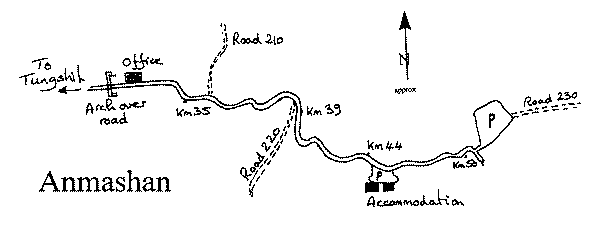
Several specific areas are recommended:
Road 210. This is the only track along which Mikado Pheasant is seen regularly. This wide, easily-walked forestry road starts just after the main entrance and the 35 Km marker, and winds its way, mostly on the level, for some considerable distance through forest, forest edge and some open areas. We followed it for several kilometres with no sign of it ending. I think, in theory this track is not open to the public, but visiting Taiwanese birders all seem to use it, and no one said anything to us. We saw four Mikado Pheasant along this trail, though all were shy - walking quietly will pay dividends. Other good birds seen/heard along this track were Taiwan Partridge, Ruddy Laughingthrush, Taiwan Shortwing, Collared Bush-Robin and Ashy Minivet.
Road 220, or that which I took to be (it has no sign), starts by the 39 Km marker, and is another wide forestry track winding through a variety of forest and scrubby areas. This is a regular place for Swinhoe's Pheasant, of which we found a tail feather, but no living birds. The best area is apparently the open understorey a couple of kilometres in. This area is quite distinctive and can be recognised by the clear view into a gentle, downhill slope beneath large trees, and is covered with low bushes which are presumably one of the food-plants of the pheasant.
Road 230, of which we only explored a small portion, starts from the car park and cafe near the top (around the 50 km marker). We only followed this a short distance. The higher elevation makes this a reliable area for Taiwan Laughingthrush, Yellowish-bellied Bush-Warbler and Streak-throated Fulvetta. Taiwan Flamecrest should occur in pines at this altitude.
Species recorded at Anmashan:
Oriental Honey-Buzzard 3 |
Inornate Warbler 1 |
Kukuan and Pasienshan, Taichung county
The forests around Kukuan, at an altitude of around 750 metres in the central highlands, support a host of mid-elevation species, including the much sought after Taiwan Magpie. Pasienshan is a forested recreation area just to the southwest of town, and is one of the best places in Taiwan to search for the magpie, though we dipped in two attempts. It's even illustrated on several visitor boards, depicting the interesting birds for dudes! As Kukuan is a hot spring resort, usually it is packed to overflowing at weekends, when finding accommodation can be a problem. Kukuan is situated on the main cross-island Highway 8, about one hour’s drive (45 kilometres) east of Fengyüan. Food and accommodation are found everywhere in town. Accommodation is also available in the recreation area (see below). Birds can be found wherever forest remains, with the following places particularly recommended:
Hotel area. Surprisingly the footbridge over the river between the hotel areas can be very productive. Taiwan Whistling-Thrush should be found easily by scanning the river, and Little Forktail is a possibility. Russet Sparrow can sometimes be found in the minimal scrub around the car park at the southern end of the main suspension bridge. In this area we had Collared Finchbill, Plumbeous Redstart, Varied Tit, and Streak-breasted Scimitar-Babbler. At the northern end of the bridge follow the road up to a small parking area, and pass through the buildings to the park-like area behind. In winter, this open area with scattered trees is good for thrushes. The forest at the rear can hold other species of interest. Mountain Scops Owl calls from here and other places around town, and even Taiwan Magpie is a possibility.
Pasienshan. Undoubtedly the best area around Kukuan is the Pasienshan Forest Reserve. The entrance is not signed - at least not in English - but is the road branching off to the south, just after the road bridge crossing the main river below Kukuan. The water gushing from the roadside rocks here is natural spring water, and appears to be a free-for-all for anybody wanting it.
|
During our visit, the park was open from 07:00 to 17:00. The entrance fee, which I forget exactly, was around NT$ 100 for the car plus NT$ 100 per person. Once inside the main gate, scan the river from the road bridge, and explore the track along its bank. The river is good for Taiwan Whistling-Thrush, Brown Dipper and Little Forktail. From the river, the road winds up a few kilometres to the main parking area of Pasienshan. All along this route good views can be gained of the forest, and scanning here would surely produce a group of Taiwan Magpie eventually. Once at the car park, numerous trails can be explored, any of which might be productive. The Yellow Tit, another species illustrated on the visitor boards, appears to be a winter altitudinal migrant only. Other good species include Brown Bullfinch, and Varied Tit (common). |
Accommodation in the form of lodges is available in the recreation area, but advance reservations required. No camping permitted.
Suspension bridge. From the footbridge between the hotels you will see another, wider, footbridge about 200 metres down-river. Crossing this, will bring you to a small area of forest edge, where again, any of the interesting birds might be found.
Km 3.6. One relatively quiet area of forest with free access can be found along a minor road branching off to the north, about 3.6 km east of Kukuan. This road leads to some official buildings, with a barrier and guard, after about 600 metres. However, the forest along the road is quite productive and definitely holds Taiwan Magpie. I also found a small steep trail, which evidently led down to the river, but didn't have the time, nor the inclination, to explore it. Birds of note seen here have included Dusky Fulvetta, Strong-footed Bush-Warbler, Hwamei and Vinaceous-breasted Parrotbill. Streak-breasted Scimitar-Babbler is common.
Dragon Valley. Although not explored by us, the Dragon Valley as mentioned in the Lonely Planet guide, has a three kilometre walk to a waterfall (which might pass through interesting forest?) Definitely a place to be avoided at weekends though.
Species recorded in and around Kukuan and Pasienshan:
Mandarin |
Black-throated Tit 70+ |
Mt. Hohuan (Hohuanshan) and Tayuling, Hualien county
One good high-elevation site is Mt. Hohuan (Hohuanshan). Although this site is not rated as highly as Yushan National Park, it offers very productive roadside birding, in addition to a few specialties. Access is via Highway 14 from Tayuling at one end, or Wushe (Jenai) the other. The road, now paved, is in good condition, but is steep and narrow in places, and with the pass at the summit of around 3,500 altitude, fog, wind, and rain can make driving hazardous. The Sunghsuehlou lodge can be found a couple of kilometres north of the pass.
Good birding occurs along the entire stretch. Starting from Wushe, the road ascends the mountain, passing through vineyards and apple orchards. Although not too exciting during summer, winter can produce Red-flanked Bluetail, Daurian Redstart, Eurasian Siskin, Little Bunting, Eyebrowed Thrush, Pale Thrush, and Cinnamon Sparrow. Vinaceous-breasted Parrotbill can be found in any rank grassland. Above the vineyards, the road passes through large tracts of mixed broadleaf and pine forests where many of the resident specialities occur including Golden Parrotbill if you are lucky. The rare White-throated Laughingthrush also occurs. Hohuan is at the crest of this road, where Alpine Accentor have become very accustomed to human handouts in the summit parking lot, and a few mobile stalls sell hot coffee and corn on the cob in the often freezing conditions.
Accommodation and food can be most easily found in Wushe (see Wushe section below) or Lushan, either of which make a good base for a couple of days. Tayuling has an expensive restaurant-hotel a couple of kilometres out on the Hohoun road, and there is supposedly a cheap hotel/hostel in the village itself, though we couldn’t find it (now closed down?). Apparently a cheap hotel can be found at Kuanyuan, 5 km east of Tayuling, Tel: (04) 599-1173. Fax: (04) 599-1159. Some of the better birding areas are described below:
Sungkang: Twelve kilometres above Wushe, at an altitude of 2,040 metres, you will see an entrance-road off to the right through an archway. Just past this point, again on the right, is a small footpath climbing the bank. This follows a water pipe to a water source and a ridge where Yellow Tit, and other interesting species, have been seen (Gardner, 1996).
Tsuifeng: Just before the sign for the village of Tsuifeng, a very obvious forestry track, with a blue gate, goes off to the left, adjacent to a convenient parking spot. This forestry track passes through an excellent variety of forest, and is easily the best birding spot on the mountain. The track continues for several kilometres at least, as we never found the end, though it was becomes more overgrown and less used after 2-3 kilometres. Both Swinhoe’s Pheasant and Mikado Pheasant are known from the area, though the former is far more likely to be found. Despite the rain, in our few hours here we recorded Swinhoe’s Pheasant, Yellow Tit, Taiwan Barwing, and a host of other specialities. This track also appears to be a reliable site for the often-elusive Brown Bullfinch.
Mount Hohuan: the car parking area at the summit itself has Taiwan Laughingthrush and Alpine Accentor. Any stands of pine trees, along the road, on either side of the summit will likely hold the Taiwan Flamecrest that appears common in the area.
Tayuling: Birding around the village of Tayuling, on the southern side of Mount Hohuan, is well worthwhile. Just before the village, the main Highway 8 passes through a tunnel, at the western end of which is a small parking spot and a hiking trail that passes through a variety of forest edge, and winds for several kilometres, largely on the level. It was along here that I miraculously ran into a Mikado Pheasant right on the path. One disadvantage of this trail is the copious quantity of grass lining the edges of the trail. If wet, even from dew, you should expect to get very wet legs and feet as you brush against it. This trail appears to be a reliable spot for Taiwan Bush Robin. Additionally Yellowish-bellied Bush-Warbler and Mountain Scrub-Warbler should be readily found.
Species recorded in the Mount Hohuan and Tayuling area:
Eurasian Kestrel 1 |
Taiwan Liocichla 10 |
Wushe (Jenai), Nantou county
Wushe, also labelled Jenai on many maps, is a small town whose location provides access to some interesting mid-elevation forest, and well as making a good base to explore Mount Hohuan (previous site). Access is along highway 14, either from Puli to the west, or from Lishan, up and over Mount Hohuan to the east. Being very touristic, accommodation can be found in Wushe itself, or the nearby town of Lushan (also called Fushih) 12 km to the east, which appears to consist of nothing other than hotels. Some birders have stayed at the Hotel Wu Ying in Wushe town centre, and rate it favourably. We stayed in Lushan near the river, but wouldn’t necessarily recommend it. Food stalls, restaurants and shops are everywhere. Usefully, Wushe has a petrol station. If possible try to avoid visiting this area over weekends and holidays when everything is packed to overflowing.
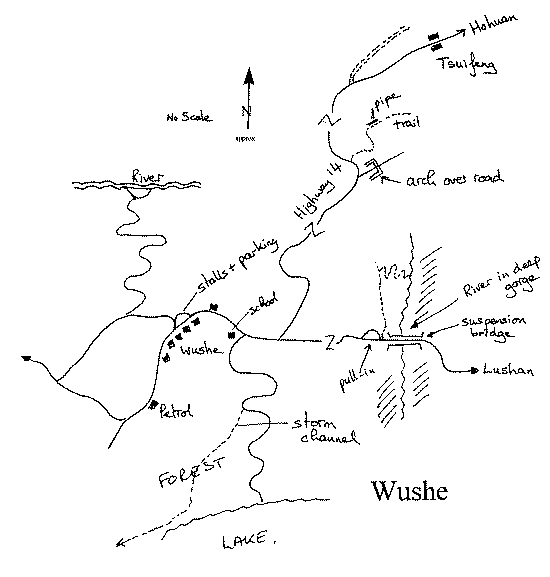
Taiwan Magpie occurs in small numbers in any of the surrounding forest, though here it is at the upper limit of its altitude range. To search for the magpie, try scanning the forest below town, behind the lake or river, or alternatively the gorge and trail a few kilometres to the east along the road to Lushan (see below). Birding can be done wherever forest or forest edge remains, though the following areas are considered the best:
Road/trail to Lake: A narrow road from the Wushe elementary school leads down to Wushe Lake Dam. The road itself is not very interesting, and only leads to the lake where views of the surrounding forest can be found. However, about half-way down, on the right, a trail leads off into the forest along the edge of a concrete storm channel. This trial passes though good forest and after a few hundred metres reaches the lake edge, where it continues through forest edge along the lakeside. Swinhoe's Pheasant has been seen along this trail, and in winter Siberian Rubythroat, and Olive-backed Tree Pipit occur. White-tailed Robin was common, and I also saw Scaly Thrush.
Road/trail to River: Another road leads off from the centre of town near the market stalls. After a hundred metres a narrow road braches off, hard on the right. This descends, as a series of hairpins, to the river. Although in general the habitat is very open, some dense undergrowth and forest edge looks interesting. Malaysian Night-Heron has also been seen toward the river.
Suspension bridge: Four kilometres east of Wushe, toward Lushan, the road traverses an impressive suspension bridge providing excellent views into a deep, extensively-forested gorge. If it is a weekend the road will be lined with camera-clicking Chinese posing for family snapshots, and hanging over the rails. Limited access to the forest is provided by a short trail from the northwestern corner of the bridge. This passes through forest and after a few hundred metres ends to the river in the bottom of the gorge. This is apparently a regular spot for the magpie, though we failed to find it. White-bellied Pigeon and White-vented Needletail were species of note seen.
Species recorded around Wushe:
Cattle Egret 20 |
Pacific Swallow 20 |
Taroko National Park, Hualien county
The impressive gorges of the Taroko National Park are quite rightly considered one of the seven wonder of Asia. With or without birding, go and pay a visit. Some 20 kilometres of the eastern end of the Central Cross-Island Highway 8 run directly along the river at the base of the gorges which in itself is an incredible feat of engineering. The towering marble cliffs, hundreds of metres high are sometimes so close that you can almost throw a stone from one side to the other. This is Taiwan’s top tourist attraction, with plenty of roadside pullouts for photography. Where the gorges widen out, forest can be found, and within its altitudinal belt Taiwan Magpie occurs. Other mid elevation birds occur, and the eastern end of the highway, approaching the coast, is the northern limit of the range of Styan’s Bulbul. Beware though that this is the contact zone with Light-vented Bulbul, with hybrids fairly common. For “good” Styan’s Bulbul continue as far as the eastern coastal lowlands. Seawatching from Chilai point just north of the city of Hualien can be good, if you have time to spare.
Hsitou, Nantou county
Hsitou, about 70 kilometres south of Taichung, protects a large area of natural and bamboo forests. Surprisingly, this site was disappointing, due mainly to the apparent inaccessibility of the better forest, and not least it was overrun with tourists. We gave up after one night, although we had planned to spend two. Nevertheless Hsitou probably offers the best chance to find Taiwan Partridge, which are regularly reported.
|
The main habitat in the most accessible areas is mostly pines which are rather unexciting for birds, though Taiwan Barwing was commoner here than anywhere on our trip. The undergrowth along streams is a good place to look for Taiwan Pygmy Cupwing. The Taiwan Partridge can be found along any trails, but you need to be out very early to be on the trails before the early-morning joggers. One nasty problem at Hsitou is the “good” state of the trails. In an effort to make things accessible, all the main trails are paved, which in the shade of the forest has become algae-covered and incredibly slippery. Several people per weekend must have serious accidents on these trails. Be very careful. Hsitou is well-signposted off highway 3 south of Taichung, and has a NT$200 entrance fee, plus a further NT$100 for the car. Accommodation within the reserve is available at several hostels and hotels. We stayed at the cheapest available which was NT$900/double. There are several cafes and small shops. We birded the main trail up through the middle of the park toward the large cedar tree. In the early morning this was good for Dusky Fulvetta. |
Species recorded at Hsitou:
Crested Goshawk |
Ferruginous Flycatcher |
Alishan, Nantou county
Alishan is 2,000 metres above sea level and takes about two hours to reach by car from Chiayi. Alishan boasts a number of cherry trees, and when they blossom in May and June, many kinds of birds collect here. An entire day, or several days, can be spent enjoying the birds, flowers, and mountain scenery at Alishan.
Yushan National Park, Nantou county
Although Yushan National Park might be considered Taiwan’s foremost birding site, lack of facilities make this a destination only for those with more time, as hiking and camping are the only real way to effectively reach the most interesting species. Birders with little time should visit Tatachia Saddle. With more time try the ancient path through the Patungkuan Ancient Path to Kuankao. The best base is Tungpu south of Shuili, which is used by climbers trekking up Mount Yushan. Birding is best done by taking the trail to the summit. Both Swinhoe’s Pheasant and Mikado Pheasant can be found, but the later is higher on the mountain and difficult to reach within a single day’s hike. However, working the lower sections of the trail, all the commoner endemics should be found. The bird list for the park is impressive. See Cin-Ty (1994) for a good description of birding the main trail toward the summit.
Species recorded at Yushan:
Mikado Pheasant |
Dusky Fulvetta |
Fuyuan, Hualien county
Fuyuan, on Highway 9 about 79 kilometres south of Hualien, has forest reputed to be good. A campsite, simple rooms and some forest cabins and a restaurant are available. Reservations required.
Tsengwen Hsi Ko, Tainan county
Not visited by us. The Tsengwen Estuary, just northwest of Tainan on the southwest coast is the place to see the endangered Black-faced Spoonbill, about 200 of which winter there (around 50% of the world population). Tsengwen is also one of the best places, again in winter only, to find Saunder’s Gull and Slaty-backed Gull, small numbers of which can be found on many of the Taiwan estuaries. Tsengwen is currently fairly intact, but is constantly threatened by nearby industrial expansion, and its future is in no way secure. Waders, ducks, and shorebirds are another key reason to visit Tsengwen. Apparently, local birders have painted bird ‘signs’ on the pavement making it easy to find the river mouth - very nice. Whilst in the area, check out the flooded fields on the west side of highway 17 just south of the Tsengwen River crossing for ducks, crakes and waders.
Chiphen, Taitung county
One of the many supposed stakeouts for Taiwan Magpie is Chiphen on the east coast just south of Taitung. Although we failed to see the magpie, Chiphen was enjoyable, the birding quite good, and the only site we recorded Spot-breasted Scimitar-Babbler and Maroon Oriole; apparently a reliable stakeout for the latter.
Many other low and mid-elevation birds occur, though we had insufficient time to explore the extensive-looking forests higher up.
|
Chiphen is yet another of those Taiwanese touristic hot-spring complexes best avoided at holidays and weekends. It was also the most expensive area we visited, although by arriving on a rainy mid-week afternoon we negotiated a good deal on accommodation. Food was notably expensive. Accommodation is hardly a problem as the place is packed to overflowing with hotels, and touts will try to attract your attention as you drive through town. Ditto for food establishments which litter the streets. Chiphen is well signposted as you drive south on the main highway from Taitung. |
Forest edge, and hence birding, starts from the suspension footbridge upward and into the deep valley in which Chiphen sits. The suspension bridge provides access to the Chiphen Forest Recreation Area, and could well be interesting for birds. However, we simply continued along the road, uphill, leaving the car once we could drive it no further, continuing on foot. This road actually continues up the mountain, eventually to the west coast in Pintung. A single Maroon Oriole was seen in the open area where the broken road does not permit a two-wheel drive to continue farther. Spot-breasted Scimitar-Babbler was found just after the waterfall.
Species recorded at Ciphen:
Little Heron 1 |
Barn Swallow 20+ |
Kenting National Park, Pingtung
Kenting National Park is at the extreme southern tip of Taiwan. Like most national parks, accommodation is available but booking is necessary. The park is noted for its scenic beauty. Most Taiwanese birders come here for the raptor migration. The lower elevation slopes are covered with broadleaf forest, and the climate is much dryer than the rest of Taiwan. Birding can be done anywhere good habitat is found. Brown-cheeked Bubul and Whistling Green-Pigeon are possibilities, but are both more easily found on Lanyu. Also try the Oulanpi Peninsula for migrants and seawatching, and the large Lungluan Lake en route for ducks and waders.
Shanping, Kaohsiung county
A reliable stakeout for Taiwan Magpie, Maroon Oriole, and probably Oriental Cuckooshrike. No further details.
Tsu Yun Shan Nature Reserve, Kaohsiung county
Not visited by us. The Tsu Yun Shan Nature Reserve Area, established in 1992, covering an area of 6,250 hectares, with elevations ranging from 400 to 2,770 metres, has a reputation as one of the best birding spots in Taiwan. However, it is also one of the most difficult to access.
Species recorded from Tsu Yun Shan:
Crested Goshawk |
Rusty Laughing Thrush |
Lanyu (Orchid) Island, Taitung county
Lanyu, or Orchid, Island lies 62 kilometres southeast of Taitung on the east coast. Although none of the Taiwan endemics occurs on the island, it makes an interesting side trip, as a few of the resident species either do not occur on the mainland, or are found much more easily here. These are Ryukyu Scops Owl, Black Paradise-Flycatcher, Whistling Green-Pigeon, Slender-billed Cuckoo-Dove and Brown-eared Bulbul. Due to its location, the island is also a natural migrant trap. As Lanyu is small, a one or two night stay is sufficient.
The scenery is quite spectacular, and the relaxed pace of life, compared to the mainland, is a refreshing change. The inhabitants are not Chinese, but people of the Yami aboriginal tribe, who are more closely related to the people of the Philippines and Pacific. The betel nut habit is rife, almost everyone has red, rotting teeth.
Arriving on Lanyu is easy, as Taiwan Airlines operate a daily flight from Taitung airport. As they have no office in Taipei, it’s necessary to make a reservation at their Taitung office. It is possible to just turn up at the airport, but don’t bank on getting a flight the same day, as the planes are only 8-seater, and frequently full. The return flight in October 1997 cost NT$ 2,100. For those with more time, an alternative would be the twice-weekly boat. However, this is unreliable and only sails if there is sufficient cargo or passengers. The only hotel accommodation is at the Lanyu Hotel, located in the Village of Imorod, and the Orchid Hotel, located in the village of Iratai. We checked out the Lanyu Hotel which was about NT$ 1,800 for a double, but had nothing special to recommend it. By asking around, or more likely being accosted at the airport, you will probably find private accommodation. We stayed in a “guesthouse” just down from the Lanyu Hotel for a price of NT$ 1,200, which was fine, but not exactly a bargain. It did have the advantage of a kitchen to prepare your own food if wanted. Budget accommodation is possible. Each village has one catholic and one Protestant church. By approaching the person in charge, one is sometimes allowed to stay for a token fee (NT$100 a night?). Evening meals are available in the hotels, or in one of the few eating establishments nearby. During lunchtime all these, including the hotel, were closed, so it is necessary to buy pot-noodles or such-like from the small shops around. Canned drinks and bottled water are available. As the choice of snack food is rather limited, bringing some from Taitung is a good idea.
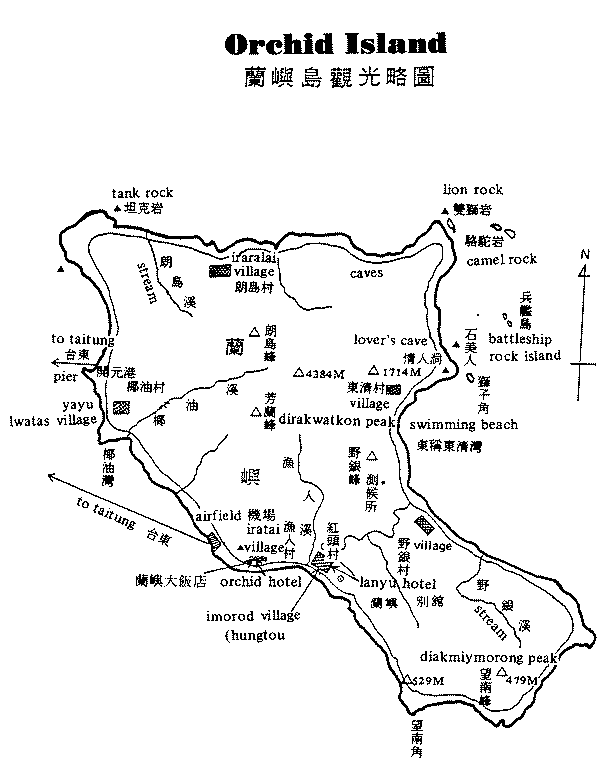
Getting around on Lanyu can be achieved by renting a motor-scooter for NT$ 600/day, or walking. As distances to the birding areas are not great, walking is a viable alternative if funds are short. A single paved road runs the 34 kilometres around the island, with a single cross-island road passing by the weather station above the main village.
Birding can done anywhere forest remains, but the southern end of the island provides the easiest access to forest, or at least is the most staked-out region. The best spot for the Ryukyu Scops Owl is the small school directly behind the Lanyu Hotel. A number of trees surround the playground, from which the owl regularly calls. In fact it’s probably possible to get this owl in trees anywhere around the village, as well along the road to the weather station which runs behind the school. Other possible owl sites are the military camp just to the east of Imorod Village. This will depend a little on if they allow you to enter or not, otherwise check the street lamps running along the road outside. Also possible is the dormitories of the power company a bit to the north of Yayu Lwatas Village, and anywhere around Imorod village.
For the Black Paradise-Flycatcher, some adventuring into the dense forest is necessary which, owing to the terrain, is more easily said than done. The easiest access is along a dried-up stream bed below a small bridge along the main road a couple of kilometres south of Hongtou village. A tiny trail leads down into the forest beside the bridge (south side), and you follow the stream bed inland, occasionally having to scramble over boulders. The bridge can be recognised as it is the last forested bridge. Just after crossing the bridge the inland side of the road turns into long rank grassland rather than forest. You have then gone too far. The paradise-flycatcher is supposedly quite common here, and vocal during breeding season. However, we failed to find one. Obviously, this is not the only place where the paradise-flycatcher exists on the island, but no other stakeout appears to exist and we couldn’t find one elsewhere.
The Taiwan Green Pigeon can be encountered anywhere flying over, though the favoured area (by local birders) are the lower forested slopes a couple of kilometres south of Hongtou village, which can be scanned from the road. The endemic subspecies of the Swinhoe's White-eye, Slender-billed Cuckoo-dove and Brown-eared Bulbul are all common. The best season for birding at Orchid Island is probably April-May, or October when passing migrants add to the birds you might encounter. Other, it's just the specialities plus a couple of other common species such as Lesser Coucal. If/when you have seen all the specialities, it is interesting to ride around the island, which is very scenic. Other birding possibilities are to investigate the flooded fields scattered all around the island for waders and migrants. Sea-watching must be good on occasions. Be aware that ticks on Lanyu carry Lyme’s Disease, not found on mainland Taiwan.
Species recorded on Lanyu:
Pacific Reef-Egret 12 |
Ruddy Kingfisher 1 |
Penghu Islands
The Penghu islands are located in the Taiwan Strait to the west of central Taiwan. The islands are served by boat and plane, and are a quite relaxed tourist destination. Breeding seabirds in summer are the main attraction with Black-naped Tern, Brown Noddy, and Bridled Tern.
Section 1 - Introduction, logistics, itinerary and general information.
Section 2 - Birding sites.
Section 3 - Systematic list.


